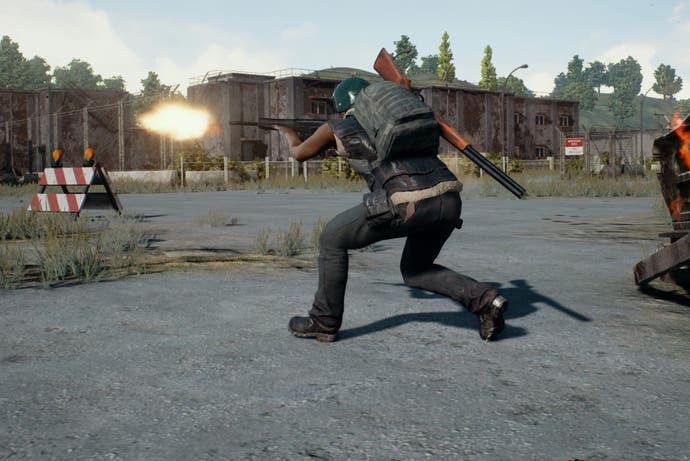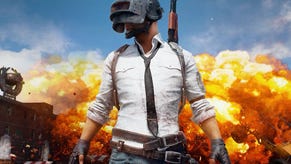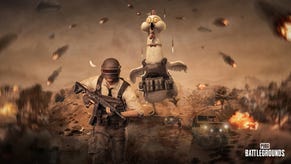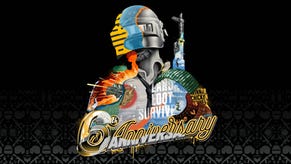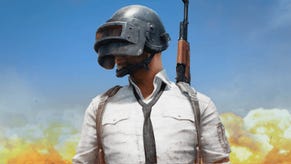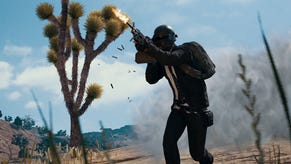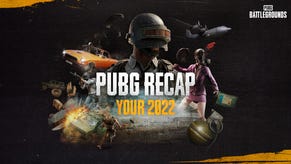PlayerUnknown's Battlegrounds review
What, me quarry?
Let's start at the top: in PlayerUnknown's Battlegrounds, 90 to 100 players parachute from a cargo plane on to one of two islands - either temperate Erangel, which has been in the game since its early access launch, or the desert Miramar, which is new. Once on the ground these players, clad only in whatever rags that loot chests have granted them, raid abandoned buildings for weapons and scramble to kill each other while avoiding a vast forcefield that slowly closes in on a narrow area of a map. Die and you are kicked back to the title screen: survive and, er, you won. That's it. Battlegrounds can be played solo or with a team, in first or third person, but this weaponised form of hide-and-seek is what it amounts to.
This formula has made Battlegrounds one of the biggest games in the world, with a seemingly universal appeal: it is both the game that boosted Steam's presence in China and the game that my friends who play one game every five years are playing. It's a truth apparently unacknowledged that what the world really wanted was paintball-on-demand, and the rewards for the first game to successfully render this experience outside of ArmA mods and H1Z1 spinoffs are apparently limitless.
Battlegrounds is not, on the surface, a particularly elegant game. Its strengths are in scale, not detail, and it has not quite risen above the sterility shared by most games with military sims in their DNA. There are vague gestures at this being some sort of edgy TV show, a flame motif logo that looks like a bad tattoo and a cast of appallingly-dressed mute weirdos. Theme and atmosphere don't matter much here however because these things are provided by the scenario itself and, crucially, by your friends.
To get straight to the heart of it, PlayerUnknown's Battlegrounds is successful both as a game and as a business proposition because it is fundamentally social. This unfenced form of shooter where it is fully possible to go half an hour without seeing an opponent or firing a gun is an ideal place to spend time with people, a shared survival story that regenerates itself every time you load into a new game. Your successes and failures, lucky weapon finds, long range kills and moments of vehicular bravado mean more because other people see them, and because they contribute to the feeling that maybe - just maybe - this run will be the one where you finally make it to the end.
Your imagination does a substantial amount of the heavy lifting, here. At any given time, the excitement of a Battlegrounds match is bound up in your sense of what might happen, rather than what eventually does. After all, this is a game where only one player or one team walks away feeling one hundred percent good about what just happened: and yet somehow, despite the most consistent experience of Battlegrounds being failure, it retains its appeal. Hell, it's often fun to fail: my favourite matches are frequently the ones where I'm forced to survive in the bushes with a crossbow, rather than the ones where the first house I raid contains a lovely UMP submachine gun with all the trimmings.
I don't think it's too much to say that Battlegrounds has played a role in rehabilitating failure in the minds of competitive players. You have to be okay with losing when losing becomes this likely: you have to become willing to extend a bit of empathy to the people who get picked off, because the same will almost certainly happen to you. This is one of the factors that makes Battlegrounds such an ideal spectator experience - it is exciting to watch good players to do well, but it is also funny and relatable to watch helpless players do badly. That Battlegrounds is so inviting to streamers and YouTubers is a happy accident of its design, but goes some way to explaining why it has been such a staggering success.
There's elegance to its design, too, however. Although the battle royale experience did not originate here, Battlegrounds manifests it in a refined form. That's evidenced by how the game thrived despite having, for the better part of a year, a single map. A simple set of randomised parameters ensure that while the landscape of the game doesn't change, your experience of it does. The first of these is the exact angle of the deployment plane, which determines the range of locations you might be able to jump directly to. The second is the placement of the first, largest safe circle, which determines whether your game will be the story of an exodus to the other side of the map or a tense hold-out from deep inside 'safe' territory.
There are hundreds of more granular factors beyond this: the randomised placement of gear and consumables, the availability of bikes, jeeps, buggies and boats, the crates loaded with rare gear that descend in each new safe zone promising opportunity and danger. As your experience with Battlegrounds increases, you gain a measure of understanding of the odds involved in a given scenario, and success is as much a matter of risk management as marksmanship. Experience conveys other benefits too - you gain the ability to curate your time with the game, understanding that a wilderness drop will lead to a slower and more ruminative match while landing in the school or airfield will mean an immediate, deadly scrap. Each option has its appeal.
Over time, Battlegrounds encourages the magical thinking of a hardened gambler. This isn't quite the slot machine experience of cracking open loot chests or card packs, but there's something equivalent in the way you come to approach each bathroom, each kitchenette, each outdoor shed. The contents of these places establish, to a great extent, whether you're about to do well or not. The character of a given match is determined by the types of weapons, attachments, gear and ammunition you find and the order in which you find them: this is fun but also substantially random. You're spinning a wheel every time you play, gambling great chunks of your time on whether that first village contains an assault rifle or five different instances of the same machete and a baseball cap.
This weakens Battlegrounds as a solo experience. When the novelty factor fades, the game can feel a little too much like rolling dice - not simply in terms of whether you win, or whether a given match contains one of those moments that you'll remember. It's compulsive but thin when the magic doesn't happen, and there's the sense that all of Battlegrounds' systems - from gunfights to multi-seat vehicles - are better with a squad. Which is not to say that the group experience is perfect either: a built-in and necessary weakness of the game is that sometimes people will die early and have no choice but to spectate. Whether or not this sours the experience depends entirely on your friends' happiness to be suddenly and violently benched.
More tools, features and modes of play are the solution, here - this is very much a sandbox shooter, and the more power players are given to approach it in their own way then the more consistency and longevity the game will achieve. The addition of first person only servers was an early indicator of this: curtailing the 360 degree awareness afforded by third person acts as a modifier on Battlegrounds' randomness, providing more opportunities to sneak past foes while creating just as many opportunities to be snuck up on. It's neither better nor worse than default play: it's simply an alternative, and demonstrates the capacity for the Battlegrounds formula to work in multiple permutations. The more of these there are, the stronger the game's proposition will become.
It's worth mentioning that besides the experiential roulette wheel of the game itself, Battlegrounds does feature a loot crate system with plenty of hooks for future microtransactions. Crates are purchased using points won in-game, each costing more than the last until a weekly reset. At the moment this system is not worth worrying too much about, or even thinking too much about, because Battleground's cosmetic item offering is possibly the least appealing ever conceived. Where another game might offer you a weapon skin or vibrant new costume, Battlegrounds is very likely to cough up a pair of khaki pants or a shirt that makes you look like a awkward teenage boy at a disco. It's so uninspiring that it works best as a kind of on-the-nose parody of loot chests: a dirty protest against industry greed manifest as an engine that vomits crap hats. Basically: don't worry about it.
In its 1.0 form, Battlegrounds is the year's best hangout game - the most reliably enjoyable social gaming experience that doesn't involve sharing a couch. It appears to have evaded the longevity issues that have dogged its multiplayer survival counterparts, and its success affords its developers the opportunity to invest in solutions to the doubts and weaknesses that remain. Expect studios of all sizes to vie for its position over the next few years. PlayerUnknown's Battlegrounds is ground zero for battle royale games in the way that World of Warcraft was ground zero for MMOs or League of Legends was for MOBAs - not the first, but the one that made it.
